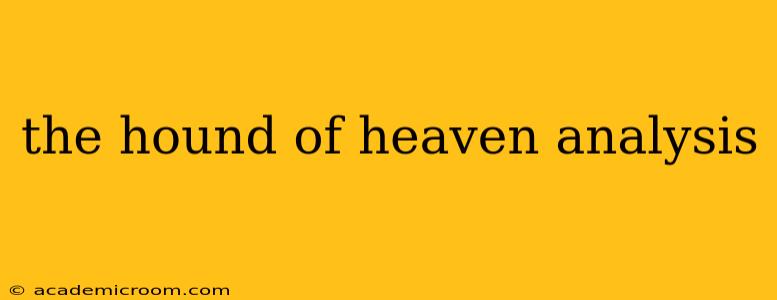Francis Thompson's "The Hound of Heaven" is a powerful and evocative poem that continues to resonate with readers centuries after its publication. More than just a religious allegory, it delves into the complexities of faith, doubt, love, and the relentless pursuit of the divine. This analysis will explore the poem's key themes, imagery, and enduring significance, addressing common questions readers have about this captivating work.
What is the central theme of "The Hound of Heaven"?
The central theme revolves around the speaker's tumultuous relationship with God, depicted as a relentless "Hound of Heaven." It's not a passive pursuit; it's a passionate, almost violent chase, reflecting the speaker's simultaneous resistance and longing for divine grace. The poem charts the journey from rebellion and evasion to eventual, albeit conflicted, surrender. The central conflict is not simply between good and evil, but between the speaker's desperate desire for freedom and independence and the irresistible pull of divine love.
What literary devices are used in "The Hound of Heaven"?
Thompson masterfully employs several literary devices to enhance the poem's emotional impact. Metaphor is paramount, with God personified as a "Hound" – a relentless pursuer, both terrifying and ultimately loving. Imagery is richly evocative, creating a vivid sensory experience for the reader. We see the speaker fleeing through diverse landscapes, from bustling cities to tranquil nature, symbolizing the varied attempts to escape God's presence. Symbolism is prevalent throughout, with the "Hound" representing divine love, the speaker's flight representing human resistance to that love, and the various landscapes representing different stages of spiritual development. The use of alliteration and assonance contributes to the poem's musicality and reinforces its emotional intensity.
What is the significance of the "Hound" in "The Hound of Heaven"?
The "Hound" is not a symbol of punishment or judgment, but of relentless, persistent love. It represents God's unwavering pursuit of the speaker, even amidst the speaker's attempts to escape. The image of the hound is powerful because it conveys both the intensity and the intimacy of God's love. It's a love that will not let go, even when rejected. The relentless pursuit reflects the persistent nature of divine grace, ever-present even in the deepest moments of doubt and despair.
What is the meaning of the speaker's flight from the Hound?
The speaker's flight is a representation of humanity's struggle with faith. It symbolizes the attempts to escape the responsibilities and demands of a relationship with God. The speaker seeks solace in worldly pleasures and distractions, attempting to find fulfillment outside the divine. The flight itself is not merely physical; it's a spiritual journey of evasion and denial, a desperate attempt to avoid confronting the profound implications of a relationship with the divine. The various settings the speaker flees to highlight the futility of seeking satisfaction in worldly things.
What does the poem's ending signify?
The ending is not a simple, triumphant surrender. It's a complex resolution characterized by both acceptance and ongoing struggle. While the speaker acknowledges the overwhelming power of divine love, the poem doesn't suggest a complete absence of conflict. The final lines hint at a continued, albeit reconciled, relationship with God, acknowledging the ongoing journey of faith and the persistent presence of divine grace. The acceptance isn't passive; it’s an active, ongoing embrace of a love that both terrifies and sustains.
Is "The Hound of Heaven" a religious poem?
While deeply rooted in religious imagery and themes, "The Hound of Heaven" transcends purely religious interpretation. Its exploration of themes like love, longing, pursuit, and the struggle between freedom and commitment resonates with readers of various faiths and even those with no religious beliefs. The poem's enduring power lies in its depiction of the universal human experience of searching for meaning and purpose, a quest that can be interpreted through different lenses depending on the reader's perspective. The central struggle – the desire for freedom versus the pull of something larger than oneself – is a profoundly human experience.
What is the style of "The Hound of Heaven"?
The poem is characterized by its intensely personal and confessional style. Thompson uses a highly emotional and lyrical language, creating a powerful and intimate connection with the reader. The poem's structure is fluid and dynamic, mirroring the speaker's turbulent emotions and experiences. The rhythm and rhyme scheme, while present, aren't rigidly structured, reflecting the unpredictable nature of the spiritual journey depicted. The overall style is intensely expressive and deeply personal, engaging the reader on an emotional level.
In conclusion, "The Hound of Heaven" is a richly layered and profoundly moving poem that continues to captivate readers with its exploration of faith, doubt, and the relentless pursuit of love. Its enduring appeal stems from its universal themes and its masterful use of literary devices to convey a deeply personal and ultimately transformative spiritual journey.
